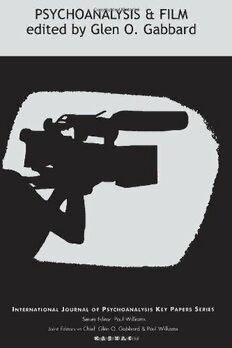
Psychoanalysis and Film PDF
Preview Psychoanalysis and Film
PSYCHOANALYSIS FILM a edited by Glen 0. Gabbard INTERNATIONAL JOURNAL OF PSYCHOANALYSIS KEY PAPERS SERIES Series Editor: Paul Williams Joint Editors-in-Chief: Glen O. Gabbard & Paul Williams K A R N AC PSYCHOANALYSIS AND FILM PSYCHOANALYSIS AND FIL M Edited and with an Introduction by Glen O. Gabbard International Journal ofPsychoanalysis Key Papers Series Series Editor: Paul Williams London and New York KARNAC First published in 2001 by H. Karnac (Books) Ltd, 118 Finchley Road, London NW3 5HT A subsidiary of Other Press LLC, New York. Arrangement, Introduction copyright © 2001 Institute of Psychoanalysis; chap ters 1-25 copyright © 2000 Institute of Psychoanalysis, republished by permis sion of the International Journal of*Psyckoanatysis. The rights of Glen O. Gabbard, Jacob A. Arlow, Emanuel Berman, Herbert H. Stein, Adrienne Harris, Harriet Kimble Wrye, Andrea Sabbadini, Simona Argen- tieri, Bruce H. Sklarew, Eric J. Nuetzel, Diana Diamond, Mechthild Zeul, Ronald Baker, Slavoj Zizek, Noel Hess, Krin Gabbard, Janine Chasseguet-Smirgel, Kim- berlyn Leary, Ronit Matalon, Donald Moss, Lynne Zeavin and Philip A. Ring- strom to be identified as the authors of this work have been asserted in accordance with §§ 77 and 78 of the Copyright Design and Patents Act 1988. All rights reserved. No part of this publication may be reproduced, stored in a retrieval system, or transmitted, by any form or by any means, electronic, mechanical, photocopying, recording or otherwise, without the prior written permission of the publisher. British Library Cataloguing in Publication Data. A CI.P. for this book is available from the British Library. ISBN 978 1 85575 275 7 Edited and typeset by the International Journal of Psychoanalysis www.karnacbooks.com Printed and bound in Great Britain by Biddies Ltd, www.biddles.co.uk CONTENTS: 1. Introduction Glen O. Gabbard 2. The end of time: a psychoanalytic perspective Wild Strawberries on Ingmar Bergman's Jacob A. Arlow, New York 3. Hitchcock's Vertigo: the collapse of a rescue fantasy Emanuel Berman, Haifa, Israel The Crying Game 4. Neil Jordan's Glen O. Gabbard, Topeka, KS 5. Hidden in the imagery: The Conformist an unconscious scene in Herbert H. Stein, New York vi CONTENTS 6. "Ah doctor, is there nothin' I can take?": A Review of Reservoir Dogs 75 Adrienne Harris, New York 7. Arthur Penn's Night Moves: a film that interprets us 83 Emanuel Berman, Israel 8. Lone Star: signs, borders and thresholds 93 Harriet Kimble Wrye, Pacific Palisades 9. Letters, words and metaphors: a psychoanalytic reading of Michael Radford's II PostinolOl Andrea Sabbadini, London 10. TrufTaut and the failure of introjection 107 Simona Argentieri, Rome 11.1 have not spoken: silence in The Piano 115 Bruce H. Sklarew, Chevy Chase, MD 12. Over-exposure: Terry ZwigofTs Crumb 121 Eric J. Nuetzel, St. Louis 13. Narrating desire and desiring narration: a psychoanalytic reading of The English Patient 129 Diana Diamond, New York CONTENTS 14. The Remains of the Day 147 Mechthild Zeul, Madrid 15. Deconstructing Dirty Harry: Clint Eastwood's undoing of the Hollywood myth of screen masculinity 153 Ronald Baker, London 16. The thing from inner space: Titanic and Deep Impact 161 Slavoj Zizek, Ljubljana 17. Chinatown 169 Noel Hess, London 18. Saving Private Ryan's surplus repression 17 7 Krin Gabbard, New York 19. M(1931) 183 Janine Chasseguet-Smirgel, Paris 20. Remembering and repeating in Eve's Bayou 193 Kimberlyn Leary, Ann Arbor, MI 21. Watching voyeurs: 201 Michael Powell's Peeping Tom (1960) Andrea Sabbadini, London viii CONTENTS 22. Egoyan's Exotica: where does the real horror reside?211 Ronit Matalon and Emanuel Berman, Israel 23. The real thing? Some thoughts on Boys Don't-Cry 221 Donald Moss and Lynne Zeavin, New York 24. 15 minutes of fame revisited: Being John Malkovich 229 Glen O. Gabbard, Topeka, KS 25. The Sixth Sense 235 Philip A. Ringstrom l. INTRODUCTION GLEN O. GABBARD In 1895 there were two auspicious births. The Lumiere brothers invented a rudimentary film projector, signifying the birth of the cinema, and Studies in Hysteria appeared, inaugurating the new sci ence of psychoanalysis. Throughout the twentieth century the two new disciplines have been inextricably linked. As early as 1900 a writer would describe his psychotic episode in terms of 'the magic lantern' effects of the nickelodeons (Schneider, 1985). By 1916 Har vard psychologist Hugo Munsterberg was applying psychological understanding to the study of the cinema. He suggested that 'the photo play* more or less replicated the mechanisms of the mind in a way that was more compelling than the typical narrative forms of storytelling. In 1931 the American film industry was already being called a 'dream factory' (Ehrenburg, 1931), reflecting the close resemblance between film imagery and the work of dreams. The cinema and psychoanalysis have! a natural affinity. Claude Chabrol, the esteemed French film-maker, reported in an inter view that he had collaborated with a psychoanalyst in the writing of his film, ha Ceremonie (Feinstein, 1996). He explained why such collaboration was useful: 'It's very hard/when you deal with char acters, not to use the Freudian grid, because the Freudian grid is composed of signs that also apply to the cinema' (1996, p. 82). The marriage between movies and psychoanalysis occurred in spite o/^Sigmund Freud. As far as we know, Freud had little regard
